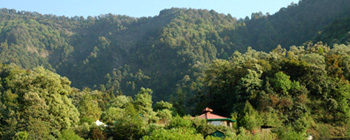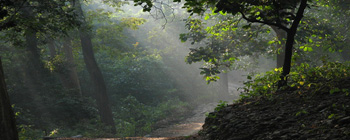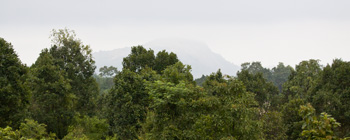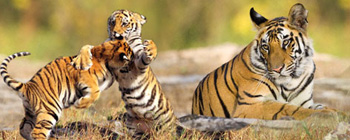All India Birding - Express Tour
This India birding tour is for birders who would like to see the maximum number of species that India has to offer over a ten day tour of Important Bird Areas spread across the country. The tour has been designed to minimise the amount of air travel required
| Region | Habitats | Sites | Target Birds |
|---|---|---|---|
| Northern India | grassland, tropical, subtropical, temperate, sub-alpine and alpine | Pangot, Sattal, Corbett National Park | Great Hornbill, Chestnut Headed and Grey Bellied Tesia, Great Slaty Woodpecker, Spotted Forktail, Long Billed Thrush, Slaty Backed Forktail, Snowy Browed Flycatcher, Red Billed Leothrix, Scaly breasted Wren Babbler, Long Tailed Broadbill, Little Forktail, Grey Headed Fish Eagle, Maroon Oriole, Rufous Gorgeted Flycatcher, Slaty Blue Flycatcher, Silver Eared Mesia, Lesser Racquet Tailed Drongo, Black Chinned Yuhina, White Crested Laughing Thrush, Small Niltava, Rufous Bellied Niltava, Bar Tailed Treecreeper, Chestnut Bellied and Velvet Fronted Nuthatch, Brown Headed Barbet, Black Stork, Little Pied Flycatcher, Changeable Hawk Eagle, Ibisbill, Wall Creeper, Fire Tailed Sunbird, Blue Throat, Black Crested Bulbul, Zitting Cisticola, Striated Prinia, Crested Treeswift, Eurasian Hobby, Collared Falconet and Rufous Bellied Eagle, Tawny and Brown Fish Owl, Little and Spotted Forktail, Pallas Fish Eagle, Silver Eared Mesia, Brown Dipper, Kingfishers, Crimson Sunbird, Red-billed Blue Magpies, Black-headed Jays, Bronzed Drongo, Mountain Bulbul, Blue-winged Minla, Pink-browed Rosefinch, Spot-winged Grosbeaks, Blue-fronted Redstart, Scarlet Finch, Green-Backed Tit, Yellow-Browed Tit, Russet Sparrow, Great Barbet, Grey-Backed Shrike, Eurasian Jay, Mistle Thrush, Orange-Flanked Bush Robin, White-Rumped Shama, Rusty-Checked Scimitar Babbler, Streak-Breasted Scimiter Babbler, Chestnut Thrush, Rufous-Bellied Niltava, Mrs Gould's Sunbird, Lammergier, Himalayan Griffon, Collared Owlet, Chestnut-Eared Bunting, Small Niltava and Slaty-Blue Flycatcher, Great Barbet, Blue Whistling Thrush, Eurasian Jay, Fire-tailed and Green-tailed Sunbirds, Scaly Breasted Wren-babbler, Black Bulbul, Black Capped Sibia, Black Eagle, King Vulture, Black Breasted Sunbird, Blue Throated Barbet, Plain Backed Thrush, Striated Laughing Thrush, Chestnut-tailed Minla, Common Wood Pigeon, Slaty-headed Parakeet, Common Green Magpie, Dark-sided Thrush, Black-throated Thrush, Himalayan Woodpecker, White-tailed Nuthatch, Blue-capped Redstart, Black-naped and brown crested Tit, Booted Hawk Eagle, Broad Billed Roller, Green, Gold and Rose Finch, Brown-fronted Woodpecker, Hill Pigeon, Mountain Bulbul, Rufous-naped Tit and Upland Pipit |
| Southern India | scrub forest, deciduous and tropical rainforests, montane forests and grasslands | Bannerghatta National Park, Ranganathittu Bird Sanctuary, Nagarhole National Park, Brahmagiri Wildlife Sanctuary | Malabar Grey Hornbill, White-cheeked Barbet, Nilgiri Wood Pigeon, White-bellied Treepie, Crimson-backed Sunbird, Nilgiri Flycatcher, Black-and-orange Flycatcher, White-bellied Blue Flycatcher, White-bellied Shortwing, Grey-headed Bulbul, Yellow-throated Bulbul, Broad-tailed Grassbird, Wynaad Laughingthrush, Nilgiri Laughingthrush, Grey-breasted Laughingthrush, Rufous Babbler, Malabar Lark, Nilgiri Pipit, Malabar Parakeet, Long-billed Vulture, Ceylon Frogmouth, Malabar Trogon, Pompadour Green Pigeon, Imperial Pigeon, Indian Grey Hornbill, Purple-rumped Sunbird, Lotens Sunbird, Tawny-bellied Babbler, Yellow-billed babbler, Black Eagle, Rock Eagle Owl, Bronze-winged and Pheasant-tailed Jacana, Chestnut-bellied and Velvet-fronted Nuthatches, Scarlet Minivet, Asian Fairy Bluebird, Common Hawk Cuckoo, Yellow-eyed Babbler, Tickells Blue Flycatcher, Asian Brown Flycatcher, Greater Coucal, Black-headed Munia, Vernal Hanging Parrot, Purple Heron, Spot-billed Pelican, Painted Stork, Asian Open-bill Stork, Black Ibis, Short-toed Eagle, Red Spurfowl, Grey Junglefowl, Yellow-wattled Lapwing, Spotted Owlet, Pied Kingfisher, Blue-bearded Bee Eater,
Booted Eagle, Peregrine Falcon, Grey Francolin, Laughing Dove, Plum-headed Parakeet, Blue-faced Malkoha, White-rumped Spinetail, Chestnut-headed Bee-eater, Crimson-fronted Barbet, White-bellied Woodpecker, Black-rumped Flameback, Heart-spotted Woodpecker, Red-rumped Swallow, White-browed Wagtail, Golden-fronted Leafbird, Greenish Warbler, Grey-headed Canary-flycatcher, Dark-fronted Babbler, Indian Yellow Tit, Long-tailed Shrike, Bronzed Drongo, Ashy Woodswallow, Chestnut-tailed Starling |
 Pangot & Sattal
Pangot & Sattal
Nainital is the headquarters of Nainital district in the Kumaon foothills of the outer Himalayas. Situated at an altitude of 1,938 metres (6,358 ft) above sea level, Nainital is set in a valley containing a pear-shaped lake, approximately two miles in circumference, and surrounded by mountains. Pangot and Sattal are a short drive from Nainital. The area and the surrounding hills are home to 200 plus species and offer fantastic views of the western himalayan range. Mixed forests dominated by oak, pine and rhododendron cover most of the area and surrounding hills.
Some of the birds that are found here include Rufous Sibia, White-browed Shrike-babbler, Spot-winged & Black-throated Tits, White-tailed Nuthatch, Slaty-backed & Little Pied Flycatcher, Long-tailed & Short-billed Minivet, Rufous-bellied & Small Niltava, Green-tailed & Black-throated Sunbirds, Griffons & Lammergiers, Streaked & Striated laughing thrushes, Grey-hooded & Golden-spectacled Warbler, Indian Blue & Orange-flanked Bush Robin, Slaty-backed & Little Forktail, Eurasian & Black-headed Jays, Wedge-tailed Green Pigeon, Hill Partridge, Red-billed Blue Magpies, Slaty-headed Parakeets, Himalayan or Great Barbet, Spot-winged Starlings, Hill Prinia, Chestnut-bellied Thrush, Rusty-cheeked Scimitar Babbler, Himalayan, Black & Ashy Bulbuls, Tickell's Thrush, Greater & Lesser Yellow-nape Woodpeckers, Lesser Racket-tailed Drongo, White-throated & Chestnut-crowned Laughing thrushes, Green-backed & Black-lored Tits.
 Corbett National Park
Corbett National Park
Corbett National Park is named after the hunter turned conservationist Jim Corbett who played a key role in its establishment and is the oldest national park in India. Situated in Nainital district of Uttarakhand the park acts as a protected area for the critically endangered Bengal tiger of India. The park has sub-Himalayan belt geographical and ecological characteristics. Dense moist deciduous forest mainly consists of sal, haldu, pipal, rohini and mango trees, and these trees cover almost 73 per cent of the park. The remaining area consists of grasslands. It houses around 110 tree species, 50 species of mammals, 580 bird species and 25 reptile species. The sanctuary was the first to come under Project Tiger initiative.
Some of the interesting birds found here are Spot-winged Starling, Great Slaty Woodpeckers, Drongo Cuckoo, Long-tailed Broadbill, Dollarbird, Lesser Coucal, Brown Crake, Pin-tailed Green Pigeon, Rosy Minivet. Black-chinned Yuhina, White-capped Bunting, Upland Pipit, Great Hornbill, Rufous-bellied Eagle, Pallas’s Fish Eagle, Lesser Fish Eagle, Sulphur-bellied Warbler, Black Stork and Black-necked Stork
 Bannerghatta National Park
Bannerghatta National Park
Bannerghatta National Park is situated 22 km south of Bangalore, Karnataka, India. This hilly place is home to one of the richest natural, zoological reserves.This 104 sq.km national park consists mostly of dense forest and scrub land, and is home to wild animals such as gaur, leopard, wild boar as well as being an important corridor for elephants migrating between the eastern and western ghats. With over 150 species of birds this park is excellent for scrub birding. The park is also home to the endemic yellow-throated bulbul.
 Ranganathittu Bird Sanctuary
Ranganathittu Bird Sanctuary
Ranganathittu Bird Sanctuary is located in the Mandya District of the state of Karnataka in India. It is occupies only 0.67 km². in area, and comprises six islets on the banks of the Kaveri River. Ranganathittu is located near the historic town of Srirangapatna and is very close to the city of Mysore.The islets came into being when a dam across the Kaveri River was built in the 1700s. The famous Indian ornithologist Dr. Salim Ali observed that the isles formed an important nesting ground for birds, and persuaded the Wodeyar kings of Mysore to declare the area a wildlife sanctuary in 1940.
The islands host numerous mammals and migratory birds. Some of them are bonnet macaque, colonies of flying fox and common small mammals like Indian gray mongoose, the monitor lizard and civet. The marsh crocodile also called the mugger crocodile is a common inhabitant of the riverine reed beds. Migratory water birds include Painted Storks, Asian Open bill Storks, Eurasian Spoonbills, Woolly-necked Storks, Black-headed Ibis, White Ibis, Lesser Whistling Duck, Indian Shag, Stork-billed Kingfisher and other birds like egrets, cormorants, oriental darter, and herons. The Great Stone Plover, and River Tern also nest here.
 Nagarhole National Park
Nagarhole National Park
Nagarhole National Park also known as "Rajiv Gandhi National Park", is located 94 kilometers from Mysore in Karnataka in South India. It is spread between Kodagu district and Mysore district. Located to the north-west of Bandipur National Park, the Kabini reservoir separates the two. The park has rich forest cover, small streams, valleys, and waterfalls. The park has a healthy tiger-predator ratio, and tiger, Indian bison, and elephant are much more populous here than in Bandipur. The park stretches over 643 square kilometres. Together with the adjoining Bandipur National Park, Mudumalai National Park and Wayanad Wildlife Sanctuary, it forms the largest protected area in Southern India, totalling 2,183 sq km.
Recognised as an Important Bird Area the park has over 270 species of birds including the 'Critically endangered' Oriental white-backed vulture, 'Vulnerable' lesser adjutant, greater spotted eagle and the Nilgiri wood-pigeon. 'Near threatened' species like darters, oriental white ibis, greater grey headed fish eagle and red headed vulture too can be found here. Endemics include the blue winged parakeet, Malabar grey hornbill and the white bellied treepie. Seven of the 15 Biome-10 (Indian Peninsula Tropical Moist Forest) and 21 of the 59 Biome-11 (Indo-Malayan Tropical Dry Zone) species have been noted from here. Some of the birds that can be sighted here include the white cheeked barbet, Indian scimitar babbler and Malabar whistling thrush. Even birds commonly seen in drier regions like painted bush quail, sirkeer malkoha, ashy prinia, Indian robin, Indian peafowl and yellow-footed green pigeon can be found here.
 Brahmagiri Wildlife Sanctuary
Brahmagiri Wildlife Sanctuary
The Brahmagiri wildlife sanctuary is an important bird area located in the Kodagu (Coorg) district and is part of the Western Ghats. It is situated on the border between Wyanad District of Kerala state on the south and Kodagu District in Karnataka on the north side. It is a short drive from the Nagarhole National Park. The sanctuary derives its name from the highest point, the Brahmagiri peak, which is 1607m in height. It covers an area of about 181km and eight rivers and streams originate in this sanctuary, and flow into the Bay of Bengal and the Arabian sea. The vegetation types include evergreen and semi-evergreen forests mainly in the low-lying areas and shola grasslands in the higher elevations.
Twelve of the 16 bird species endemic to the Western Ghats live in this sanctuary including species like the blue-winged parakeet and small sunbird.The 'Critically endangered' bird species like the Oriental white-backed vulture and globally 'Vulnerable' species like the white-bellied shortwing and the Nilgiri wood-pigeon are recorded from this sanctuary. Among the 'Near threatened' species the red-headed vulture and broad-tailed grass warbler are recorded from here. This site lies in Biome-10 (Indian Peninsula Tropical Moist Forest) and 12 of the 15 species listed under this biome are found here. These include Jerdon's nightjar, Ceylon frogmouth and Malabar trogon.
Telephone +91 98451 49783 for more information or email us today.

